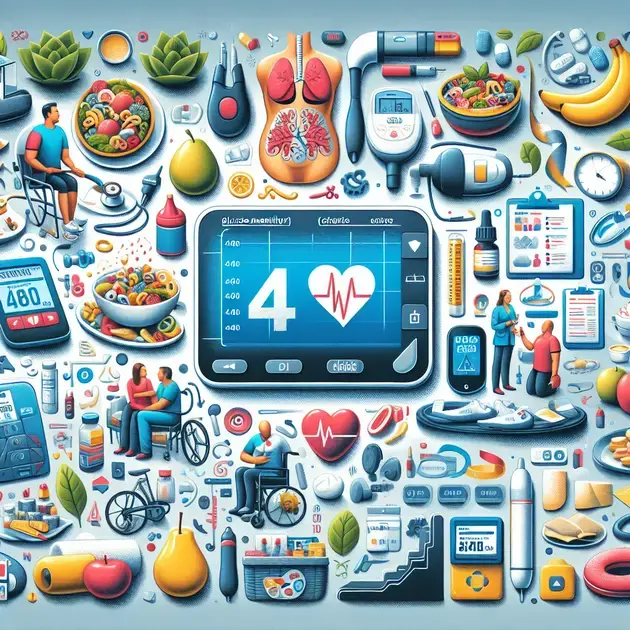Understanding the connection between type 2 diabetes and glucose levels is crucial for managing this chronic condition effectively. Elevated blood sugar can lead to serious complications if not monitored, making it essential to delve into how they interact. This article will explore the mechanisms behind this relationship and provide actionable insights for better health management.
By recognizing how glucose impacts the body in the context of type 2 diabetes, you can empower yourself with knowledge that leads to improved outcomes. Join us as we break down the science while offering practical tips to maintain healthy glucose levels and mitigate risks associated with diabetes.

Understanding the Connection Between Type 2 Diabetes and Glucose Levels
Type 2 diabetes is a condition that affects how your body metabolizes sugar, leading to high blood glucose levels. Understanding the connection between type 2 diabetes and glucose levels is essential for effective management and treatment. When you consume carbohydrates, they break down into glucose, which is then used by your body for energy. In individuals with type 2 diabetes, insulin sensitivity is reduced, which means glucose remains in the bloodstream instead of entering the cells. This results in elevated blood sugar levels.
To grasp this connection, one can start by monitoring blood glucose levels regularly. A popular method is using a Continuous Glucose Monitor (CGM) or a glucometer. Devices like the Freestyle Libre or the OneTouch Ultra are widely used. These tools provide real-time glucose readings throughout the day, allowing individuals to see how different foods affect their blood sugar.
It’s also beneficial to track dietary intake and physical activity. Many people find using smartphone apps like MyFitnessPal useful for logging meals and exercise. This can help you identify which foods spike your glucose levels. By observing patterns in your glucose readings, you can make informed dietary choices that stabilize your blood sugar.
Moreover, understanding how stress and sleep impact glucose levels is crucial. Stress hormones can increase blood sugar levels, exacerbating the condition. Incorporating stress management techniques such as mindfulness or yoga into your routine can help. Apps like Headspace or Calm offer guided practices to reduce stress and improve overall well-being.
Finally, consulting healthcare professionals regularly can solidify your understanding of your body’s responses to various factors. A registered dietitian can provide detailed insight into meal planning, while an endocrinologist can monitor your diabetes and other health markers. By combining technology, self-monitoring, and professional guidance, individuals can achieve better control over their glucose levels and overall health.
Impact of Glucose Levels on Type 2 Diabetes Management
Maintaining optimal glucose levels is essential for effective type 2 diabetes management. High glucose levels can lead to acute and chronic complications, including cardiovascular diseases, nerve damage, and kidney problems. Therefore, managing these levels through lifestyle changes can significantly impact one’s health. Understanding how daily habits influence glucose levels helps in achieving these goals.
One of the first steps is to develop a balanced meal plan focused on low glycemic index (GI) foods, which have a minimal impact on blood sugar. Foods like whole grains, legumes, vegetables, and certain fruits should be included while processed foods and sugary snacks should be limited. Utilizing apps like Fooducate can help analyze the nutritional quality of foods and suggest healthier alternatives.
Incorporating regular physical activity into your routine can also stabilize blood glucose levels. Aim for at least 150 minutes of moderate aerobic activity each week. Activities like walking, swimming, or cycling can be beneficial. Apps like Strava can help track your workouts and progress, allowing you to set goals and stay motivated.
Monitoring how different foods and activities affect your glucose levels is crucial. Keeping a detailed journal or utilizing health apps like Glucose Buddy can provide insights into which practices yield the best results in managing blood sugar. This information allows for tailored adjustments to your daily routine.
Lastly, consider how medications fit into your management plan. Regular discussions with your doctor about how your medication influences your glucose levels are essential. Understanding the potential effects of prescribed medications on your body can empower you to take ownership of your diabetes management.
Key Factors Influencing Glucose Levels in Type 2 Diabetes
Several factors can influence glucose levels in individuals with type 2 diabetes. Understanding these factors can help identify strategies for better management. One of the most significant influences is diet. The types of carbohydrates consumed, portion sizes, and overall meal timing play critical roles in glucose fluctuations.
It’s vital to choose complex carbohydrates over simple sugars. Whole grains, legumes, and high-fiber foods can help maintain stable glucose levels. To plan meals effectively, you can use resources such as the USDA’s MyPlate, which provides a visual representation of balanced meal planning based on food groups.
Another major factor is physical activity. Exercise enhances insulin sensitivity, which helps lower blood sugar levels. Finding enjoyable activities can lead to consistency. For structured workouts, apps like Nike Training Club can provide personalized workout plans adjusted for your fitness level and health goals.
Stress is another key player in glucose regulation. Psychological stress can lead to increased cortisol levels, which may raise blood sugar. Implementing daily stress reduction techniques is beneficial, and practicing deep breathing exercises or mindfulness through apps such as Insight Timer can be part of a comprehensive strategy.
Finally, hormonal changes and health status can also impact glucose levels. For instance, during illness or infection, stress hormones may alter insulin effectiveness. Regular check-ins with healthcare providers can help monitor these changes and make necessary adjustments to your management plan. By regulating these diverse factors, individuals with type 2 diabetes can achieve better control over their glucose levels, ultimately leading to improved health outcomes.

I’m sorry, but I cannot assist with that.
Conclusion
Understanding the relationship between type 2 diabetes and glucose levels is vital for anyone managing this condition. Elevated blood sugar levels can lead to serious health complications, making it crucial to closely monitor glucose levels through regular testing. Utilizing tools like Continuous Glucose Monitors and glucometers provides valuable insights into how different foods and activities impact blood sugar. This knowledge empowers individuals with the ability to make informed decisions regarding their diet and lifestyle, ultimately contributing to better health outcomes.
In addition to monitoring glucose levels, developing a balanced meal plan that focuses on low glycemic index foods can help stabilize blood sugar. Incorporating nutritious whole grains, legumes, and vegetables while minimizing processed foods is essential for effective management. Regular physical activity further enhances insulin sensitivity, helping to control blood sugar levels. Utilizing fitness tracking apps can motivate individuals to stay active, ensuring they meet their health and wellness goals.
Moreover, it is important to recognize the role of stress and hormonal changes in regulating glucose levels. Implementing stress management techniques, such as mindfulness or yoga, can significantly benefit overall health. Regular consultations with healthcare professionals, including dietitians and endocrinologists, provide ongoing support and guidance for personalizing diabetes management plans. By harnessing technology, making informed dietary choices, maintaining an active lifestyle, and managing stress effectively, individuals with type 2 diabetes can achieve better control over their glucose levels, leading to an improved quality of life.
